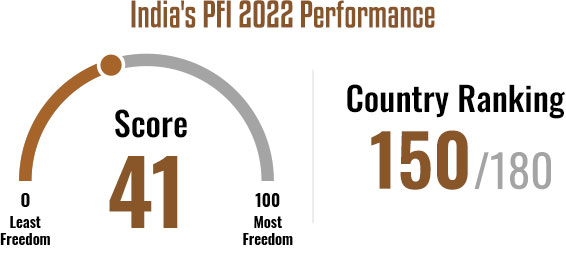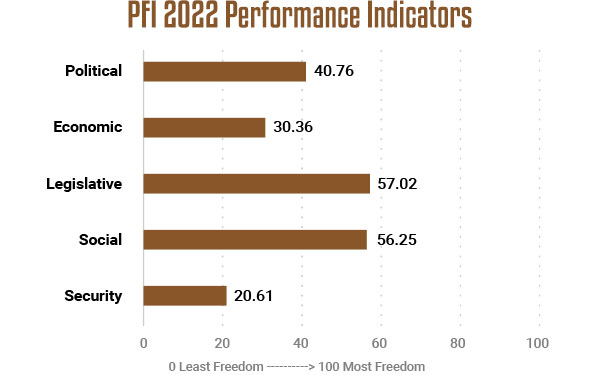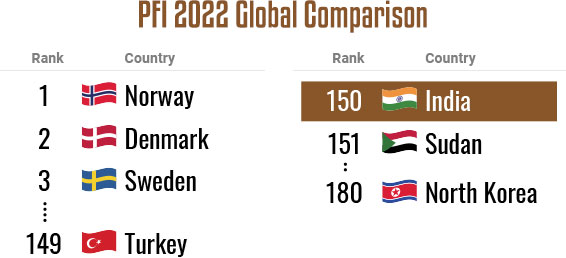
The world marked the Press Freedom day yesterday and in keeping with the practice for the 20th year in a row, Reporters Sans Frontiers (RSF) released its Press Freedom Index.
“Press freedom” is defined as the ability of journalists to select, produce, and disseminate news in the public interest independent of political, economic, legal, and social interference and in the absence of threats to their physical and mental safety.
The 20th World Press Freedom Index, published by Reporters Sans Frontiers (RSF), assesses the level of press freedom enjoyed by journalists and media in 180 countries.

India was ranked 150th amongst 180 countries for the level of freedom enjoyed by the journalists and the media in the country. India’s ranking has gradually fallen from 140 in 2013 to 150 in 2022.
The RSF has warned that press freedom in India is "in crisis" and that India is "one of the world’s most dangerous countries for the media".
The RSF’s report classifies the Indian media landscape to be like India itself – huge and densely populated – having more than 100,000 newspapers (including 36,000 weeklies) and 380 TV news channels. However, the abundance of media outlets conceals tendencies toward the concentration of ownership, with only a handful of sprawling media companies at the national level and only four dailies sharing three quarters of the readership in Hindi.
Performance Indicators for the Press Freedom Index
The overall PFI score is evaluated using five contextual indicators that reflect the press freedom situation in all of its complexity: political context, legal framework, economic context, sociocultural context and safety. The indicators are assessed on the basis of a quantitative survey of press freedom violations and abuses against journalists and media, and a qualitative study based on the responses of hundreds of press freedom experts selected by RSF (journalists, academics and human rights defenders) to a questionnaire with 123 questions.

RSF’s comments on the political context of press freedom in India
The Indian press used to be seen as fairly progressive but things changed radically in the mid-2010s, when Narendra Modi became prime minister and engineered a rapprochement between BJP and the big families dominating the media. The prime example is undoubtedly the Reliance Industries group led by Mukesh Ambani, now a personal friend of Modi’s, who owns more than 70 media outlets that are followed by at least 800 million Indians. Very early on, Modi took a critical stance vis-à-vis journalists, seeing them as “intermediaries” polluting the direct relationship between himself and his supporters. Indian journalists who are too critical of the government are subjected to all-out harassment and attack campaigns by Modi devotees known as ‘bhakts’.
RSF’s comments on the economic context of press freedom in India
The Indian press is a colossus with feet of clay. The media outlets largely depend on advertising contracts with local and regional governments. At the national level, the central government has seen that it can exploit this to impose its own narrative, and is now spending more than 130 billion rupees a year on ads in the print and online media. Recent years have also seen the rise of “Godi media”– media outlets such as Times Now and Republic TV mix populism and pro-BJP propaganda.
RSF’s comments on the legislative/legal context of press freedom in India
Indian law is protective in theory but charges of defamation, sedition, contempt of court and endangering national security are increasingly used against journalists critical of the government, who are branded as “anti-national.” Journalists who try to cover anti-government strikes and protests are often arrested and sometimes detained arbitrarily.
RSF’s comments on the sociocultural context of press freedom in India
The enormous diversity of Indian society is barely reflected in the mainstream media. For the most part, only Hindu men from upper castes hold senior positions in journalism or are media executives – a bias that is reflected in media content. For example, fewer than 15% of the participants in major evening talk shows are women.
RSF’s comments on the security/safety context of press freedom in India
With an average of three or four journalists killed in connection with their work every year, India is one of the world’s most dangerous countries for the media. Journalists are exposed to all kinds of physical violence including police violence, ambushes by political activists, and deadly reprisals by criminal groups or corrupt local officials.
How does India fare compared to its peers?
The Index ranks 180 countries for the level of freedom enjoyed by their media and the journalists.

Norway retained its top rank on the index since 2019 with a score of 92.65 followed by Denmark with a score of 90.27.
Indian Government’s response to the Press Freedom Index
The Indian government has categorically said that it does not subscribe to the report’s findings and does not agree to the conclusions drawn by the organisation. In March this year, Anurag Thakur, I&B Minister, said that the government does not subscribe to the conclusions for various reasons, including very low sample size and little or no weightage given to the fundamentals of democracy.
TO READ THE FULL ARTICLE

Get full access to the exciting content on The Mirrority by logging in
Support independent journalism
Even the very best of media houses in our country today are yielding to the pressure of click-bait journalism in order to survive. More than ever before, our country needs journalism that is independent, fair and non-pliant to the bureaucracy. Such journalism needs the support of like-minded readers like you to help us survive editorially and financially.
Whether you live in India or India lives inside you, help us continue to produce quality journalism with your contribution.
CONTRIBUTE
